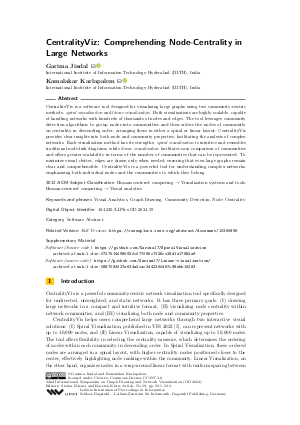CentralityViz: Comprehending Node-Centrality in Large Networks (Software Abstract)
Authors
Garima Jindal  ,
Kamalakar Karlapalem
,
Kamalakar Karlapalem 
-
Part of:
Volume:
32nd International Symposium on Graph Drawing and Network Visualization (GD 2024)
Part of: Series: Leibniz International Proceedings in Informatics (LIPIcs)
Part of: Conference: Graph Drawing and Network Visualization (GD) - License:
 Creative Commons Attribution 4.0 International license
Creative Commons Attribution 4.0 International license
- Publication Date: 2024-10-28
File

PDF
LIPIcs.GD.2024.59.pdf
- Filesize: 480 kB
- 3 pages
Document Identifiers
Related Versions
Subject Classification
ACM Subject Classification
- Human-centered computing → Visualization systems and tools
- Human-centered computing → Visual analytics
Keywords
- Visual Analytics
- Graph Drawing
- Community Detection
- Node Centrality
Metrics
- Access Statistics
-
Total Accesses (updated on a weekly basis)
0PDF Downloads0Metadata Views
Abstract
CentralityVis is a software tool designed for visualizing large graphs using two community-centric methods: spiral visualization and linear visualization. Both visualizations are highly scalable, capable of handling networks with hundreds of thousands of nodes and edges. The tool leverages community detection algorithms to group nodes into communities and then orders the nodes of community on centrality in descending order, arranging them in either a spiral or linear layout. CentralityVis provides clear insights into both node and community properties, facilitating the analysis of complex networks. Each visualization method has its strengths: spiral visualization is intuitive and resembles traditional node-link diagrams, while linear visualization facilitates easy comparison of communities and offers greater scalability in terms of the number of communities that can be represented. To minimize visual clutter, edges are drawn only when needed, ensuring that even large graphs remain clear and comprehensible. CentralityVis is a powerful tool for understanding complex networks, emphasizing both individual nodes and the communities to which they belong.
Cite As Get BibTex
Garima Jindal and Kamalakar Karlapalem. CentralityViz: Comprehending Node-Centrality in Large Networks (Software Abstract). In 32nd International Symposium on Graph Drawing and Network Visualization (GD 2024). Leibniz International Proceedings in Informatics (LIPIcs), Volume 320, pp. 59:1-59:3, Schloss Dagstuhl – Leibniz-Zentrum für Informatik (2024)
https://doi.org/10.4230/LIPIcs.GD.2024.59
BibTex
@InProceedings{jindal_et_al:LIPIcs.GD.2024.59,
author = {Jindal, Garima and Karlapalem, Kamalakar},
title = {{CentralityViz: Comprehending Node-Centrality in Large Networks}},
booktitle = {32nd International Symposium on Graph Drawing and Network Visualization (GD 2024)},
pages = {59:1--59:3},
series = {Leibniz International Proceedings in Informatics (LIPIcs)},
ISBN = {978-3-95977-343-0},
ISSN = {1868-8969},
year = {2024},
volume = {320},
editor = {Felsner, Stefan and Klein, Karsten},
publisher = {Schloss Dagstuhl -- Leibniz-Zentrum f{\"u}r Informatik},
address = {Dagstuhl, Germany},
URL = {https://drops.dagstuhl.de/entities/document/10.4230/LIPIcs.GD.2024.59},
URN = {urn:nbn:de:0030-drops-213439},
doi = {10.4230/LIPIcs.GD.2024.59},
annote = {Keywords: Visual Analytics, Graph Drawing, Community Detection, Node Centrality}
}
Author Details
Supplementary Materials
-
Software (Source code)
https://github.com/Garima17/SpiralVisualization
browse
 archived version
archived version
-
Software (source code)
https://github.com/Garima17/Linear-visualization/
browse
 archived version
archived version
References
- Stephen P Borgatti and Martin G Everett. A graph-theoretic perspective on centrality. Social networks, 28(4):466-484, 2006. URL: https://doi.org/10.1016/J.SOCNET.2005.11.005.
-
Ulrik Brandes. A faster algorithm for betweenness centrality. Journal of mathematical sociology, 25(2):163-177, 2001.

-
Santo Fortunato and Darko Hric. Community detection in networks: A user guide. Physics reports, 659:1-44, 2016.

-
Nandinee Haq and Z Jane Wang. Community detection from genomic datasets across human cancers. In 2016 IEEE Global Conference on Signal and Information Processing (GlobalSIP), pages 1147-1150. IEEE, 2016.

- Garima Jindal and Kamalakar Karlapalem. A simple yet useful spiral visualization of large graphs. In 2023 IEEE Visualization and Visual Analytics (VIS), pages 171-175. IEEE, 2023. URL: https://doi.org/10.1109/VIS54172.2023.00043.
-
Warih Maharani, Alfian Akbar Gozali, et al. Degree centrality and eigenvector centrality in twitter. In 2014 8th international conference on telecommunication systems services and applications (TSSA), pages 1-5. IEEE, 2014.

-
Mohammad Javad Mosadegh and Mehdi Behboudi. Using social network paradigm for developing a conceptual framework in crm. Australian Journal of Business and Management Research, 1(4):63, 2011.

- Kazuya Okamoto, Wei Chen, and Xiang-Yang Li. Ranking of closeness centrality for large-scale social networks. In International workshop on frontiers in algorithmics, pages 186-195. Springer, 2008. URL: https://doi.org/10.1007/978-3-540-69311-6_21.
-
Carlos André Reis Pinheiro. Community detection to identify fraud events in telecommunications networks. SAS SUGI proceedings: customer intelligence, 2012.

-
Britta Ruhnau. Eigenvector-centrality - A node-centrality? Social networks, 22(4):357-365, 2000.

- Marcel Salathé and James H Jones. Dynamics and control of diseases in networks with community structure. PLoS computational biology, 6(4):e1000736, 2010. URL: https://doi.org/10.1371/JOURNAL.PCBI.1000736.
-
Hamed Sarvari, Ehab Abozinadah, Alex Mbaziira, and Damon McCoy. Constructing and analyzing criminal networks. In 2014 IEEE security and privacy workshops, pages 84-91. IEEE, 2014.

-
Fumihiko Taya, Joshua de Souza, Nitish V Thakor, and Anastasios Bezerianos. Comparison method for community detection on brain networks from neuroimaging data. Applied Network Science, 1:1-20, 2016.

-
Todd Waskiewicz. Friend of a friend influence in terrorist social networks. In Proceedings on the international conference on artificial intelligence (ICAI), page 1. The Steering Committee of The World Congress in Computer Science, Computer Engineering and Applied Computing (WorldComp), 2012.

- Vahan Yoghourdjian, Daniel Archambault, Stephan Diehl, Tim Dwyer, Karsten Klein, Helen C Purchase, and Hsiang-Yun Wu. Exploring the limits of complexity: A survey of empirical studies on graph visualisation. Visual Informatics, 2(4):264-282, 2018. URL: https://doi.org/10.1016/J.VISINF.2018.12.006.
